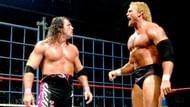#1 It began a creative and financial return to form for WWE

In mid-90s, the WWF was in a freefall from the booming Rock-N-Wrestling era of the 1980s, and by 1995, the ratings, fan interest and product quality were at an all-time low.
With abysmal booking (i.e. pointless jobbers taking up precious airtime in the single hour of Monday Night RAW), consistently disappointing pay-per-views, major stars like Sycho Sid and Mabel failing to get over and Wrestle Mania XI (main evented by a non-wrestler in NFL player Lawrence Taylor) being the lowest selling and attended 'Mania ever, things were going very poorly for the sports entertainment brand.
WWE has no plans for these former AEW wrestlers? Here's why!
But then Survivor Series happened. Goldust was just getting started and was highly entertaining. The women's 5 on 5 match, featuring Alundra Blayze and several top female stars from Japan, was a solid outing. The 5 on 5 Wildcard Match, featuring heels and faces mixed together on the same team, was a clever idea that worked well, especially with Shawn Michaels and a debuting Ahmed Johnson picking up the win.
And then there was Diesel/Hart, who brutalized each other for nearly 25 minutes and stole the show. This single night proved that despite the negatives, there were good times yet to come and things were about to change.
Despite the stiff competition from WCW, the WWF's fortunes seemed to turn around in the aftermath. Pay-per-views, as well as RAW, steadily improved in the following year, and the entertainment value of the company dramatically shot up until the Attitude Era was well under way three years later the WWF once again managed to penetrate pop culture. In retrospect, Diesel/Hart can be seen as a harbinger of good fortune that was surely to come to WWE and professional wrestling.
Even though Bret Hart and Kevin Nash both moved to the WCW, they were unable to replicate the success of their bout in the WWE.
How WWE has messed up John Cena's last run - Check here!

